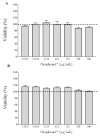Effect of a Berry Polyphenolic Fraction on Biofilm Formation, Adherence Properties and Gene Expression of Streptococcus mutans and Its Biocompatibility with Oral Epithelial Cells
- PMID: 33466319
- PMCID: PMC7824760
- DOI: 10.3390/antibiotics10010046
Effect of a Berry Polyphenolic Fraction on Biofilm Formation, Adherence Properties and Gene Expression of Streptococcus mutans and Its Biocompatibility with Oral Epithelial Cells
Abstract
The ability of Streptococcus mutans to adhere to oral surfaces and form biofilm is a key step in the tooth decay process. The aim of this study was to investigate a berry (wild blueberry, cranberry, and strawberry) polyphenolic fraction, commercialized as Orophenol®, for its antibacterial, anti-biofilm, and anti-adhesion properties on S. mutans. Moreover, the biocompatibility of the fraction with human oral epithelial cells was assessed. Phenolic acids, flavonoids (flavonols, anthocyanins, flavan-3-ols), and procyanidins made up 10.71%, 19.76%, and 5.29% of the berry polyphenolic fraction, respectively, as determined by chromatography and mass spectrometry. The berry polyphenolic preparation dose-dependently inhibited S. mutans biofilm formation while not reducing bacterial growth. At concentrations ranging from 250 to 1000 µg/mL, the fraction inhibited the adhesion of S. mutans to both saliva-coated hydroxyapatite and saliva-coated nickel-chrome alloy. Quantitative reverse transcription polymerase chain reaction (qRT-PCR) analysis showed that incubating S. mutans with the berry polyphenolic fraction was associated with a reduced expression of luxS gene, which regulates quorum sensing in S. mutans. The berry fraction did not show any significant cytotoxicity in an oral epithelial cell model. In conclusion, Orophenol®, which is a mixture of polyphenols from wild blueberry, cranberry and strawberry, possesses interesting anti-caries properties while being compatible with oral epithelial cells.
Keywords: S. mutans; anti-adhesion; anti-biofilm; berry polyphenols; epithelial cells; quorum sensing.
Conflict of interest statement
The authors declare no conflict of interest.
Figures




Similar articles
-
Effects of a Berry Polyphenolic Fraction on the Pathogenic Properties of Porphyromonas gingivalis.Front Oral Health. 2022 Jun 16;3:923663. doi: 10.3389/froh.2022.923663. eCollection 2022. Front Oral Health. 2022. PMID: 35784661 Free PMC article.
-
Inhibitory effects of fruit berry extracts on Streptococcus mutans biofilms.Eur J Oral Sci. 2019 Apr;127(2):122-129. doi: 10.1111/eos.12602. Epub 2018 Dec 28. Eur J Oral Sci. 2019. PMID: 30592324
-
Streptococcus gordonii LuxS/autoinducer-2 quorum-sensing system modulates the dual-species biofilm formation with Streptococcus mutans.J Basic Microbiol. 2017 Jul;57(7):605-616. doi: 10.1002/jobm.201700010. Epub 2017 May 9. J Basic Microbiol. 2017. PMID: 28485524
-
Inhibitory effect of cranberry polyphenol on cariogenic bacteria.Bull Tokyo Dent Coll. 2008 Aug;49(3):107-12. doi: 10.2209/tdcpublication.49.107. Bull Tokyo Dent Coll. 2008. PMID: 19129685
-
Plausible Drug Targets in the Streptococcus mutans Quorum Sensing Pathways to Combat Dental Biofilms and Associated Risks.Indian J Microbiol. 2015 Dec;55(4):349-56. doi: 10.1007/s12088-015-0534-8. Epub 2015 May 12. Indian J Microbiol. 2015. PMID: 26543259 Free PMC article. Review.
Cited by
-
Effects of BlueM® against Streptococcus mutans biofilm and its virulence gene expression.Braz Dent J. 2023 Jan-Feb;34(1):19-28. doi: 10.1590/0103-6440202305133. Braz Dent J. 2023. PMID: 36888841 Free PMC article.
-
Strategies to Combat Caries by Maintaining the Integrity of Biofilm and Homeostasis during the Rapid Phase of Supragingival Plaque Formation.Antibiotics (Basel). 2022 Jun 30;11(7):880. doi: 10.3390/antibiotics11070880. Antibiotics (Basel). 2022. PMID: 35884135 Free PMC article. Review.
-
Mechanistic insights into the inhibitory effect of theaflavins on virulence factors production in Streptococcus mutans.AMB Express. 2021 Jul 9;11(1):102. doi: 10.1186/s13568-021-01263-z. AMB Express. 2021. PMID: 34244882 Free PMC article.
-
From Waste to Health: Olive Mill Wastewater for Cardiovascular Disease Prevention.Nutrients. 2024 Sep 4;16(17):2986. doi: 10.3390/nu16172986. Nutrients. 2024. PMID: 39275301 Free PMC article.
-
Effects of a Berry Polyphenolic Fraction on the Pathogenic Properties of Porphyromonas gingivalis.Front Oral Health. 2022 Jun 16;3:923663. doi: 10.3389/froh.2022.923663. eCollection 2022. Front Oral Health. 2022. PMID: 35784661 Free PMC article.
References
-
- Cummins D. Dental caries: A disease which remains a public health concern in the 21st century-the exploration of a breakthrough technology for caries prevention. J. Clin. Dent. 2013;24:1–14. - PubMed
-
- Lamont R.J., Egland P.G. Dental caries. In: Tang Y.W., Sussman M., Liu D., Poxton I., Schwartzman J., editors. Molecular Medical Microbiology. 2nd ed. Elsevier Ltd.; Amsterdam, The Netherlands: 2015. pp. 945–955.
LinkOut - more resources
Full Text Sources
Other Literature Sources
Molecular Biology Databases

